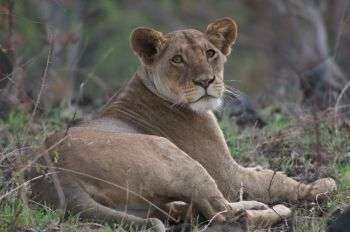African lions under same threats as extinct sabre-toothed tigers faced

The seven big cats that went extinct towards the end of the last Ice Age, including several sabre-toothed cats, are those which lost the greatest proportion of their prey, according to an international team of scientists who believe the African lion and Sunda clouded leopard are next on the list.
A new study led by scientists from the universities of Sussex, Oxford's Wildlife Conservation Research Unit (WildCru), Aarhus and Goteborg has assessed whether Ice Age extinction trends could be applied to populations of big cat species now, by using a new global database FelidDIET.
The team researched the cause of extinction of seven large cats from the Ice Age: four different types of sabre-toothed cats, the cave and American lions, and the American cheetah. They discovered that if these animals were alive today on average, only 25 per cent of their preferred prey species would still remain across their former natural ranges – the majority have gone extinct, partly due to human pressure. The team believe this devastating loss of prey species was a major contributing factor to the extinction of these big cats.
The team have also used the database to work out whether a similar decline in the availability of prey species now could lead to the demise of some of the world's most well-known big cat species. They have discovered that, if all the currently threatened and declining prey species within big cat natural ranges were to go extinct, only 39 per cent of the African lion's prey and 37 per cent of Sunda clouded leopard's would remain.
Worryingly the researchers believe that if this prey loss trend continues this poses 'a high risk of extinction' to these two big cat species in particular. They also report that prey diversity within the geographical ranges of tiger, leopard and cheetah puts them at risk too.
Dr Chris Sandom, from the University of Sussex, said: "This joint study clearly shows that if primary big cat prey continues to decline at such a rate then big cats, including lion, Sunda clouded leopard, tiger and cheetah are at high risk of extinction.
"Where prey species have, or are likely to become extinct, this poses a serious risk to the big cat species which feed on them and we now know this is the continuation of an unhappy trend which began during the last Ice Age.
"We need to buck this Ice Age trend once and for all and to reinforce the urgent need for governments to protect both big cat species and their prey."
Professor David Macdonald, Director of the University of Oxford's WildCRU, remarked: "The fairy-tale consequences of Old Mother Hubbard's cupboard being bare are all too vividly real for modern big cats. Our study of the consequences of prey loss – 'defaunation' in the jargon - is about, in everyday language 'what if' or perhaps better 'if only': without the extinctions of the Pleistocene, in which the fingerprints of humanity are all to incriminating, there would have been between one and five more felid species in most places today.
"The Churchillian aphorism that those that fail to learn from history are doomed to repeat it was painfully in mind when we saw how many of the prey of lions and East Africa and of clouded leopards in Indo-Malaya look set to go down the same drain down which their counterparts in other regions have already been flushed."
Dr Dawn Burnham, another WildCRU co-author, added: "NIMBYISM has taken its toll on our own part of the world – where today only the Eurasian lynx represents biggish cats in Western Europe, our calculations suggest there would have been at least three more large felids had the prey species survived to sustain them."
More information: Christopher James Sandom et al. Learning from the past to prepare for the future: Felids face continued threat from declining prey richness, Ecography (2017). DOI: 10.1111/ecog.03303
Journal information: Ecography
Provided by University of Sussex



















